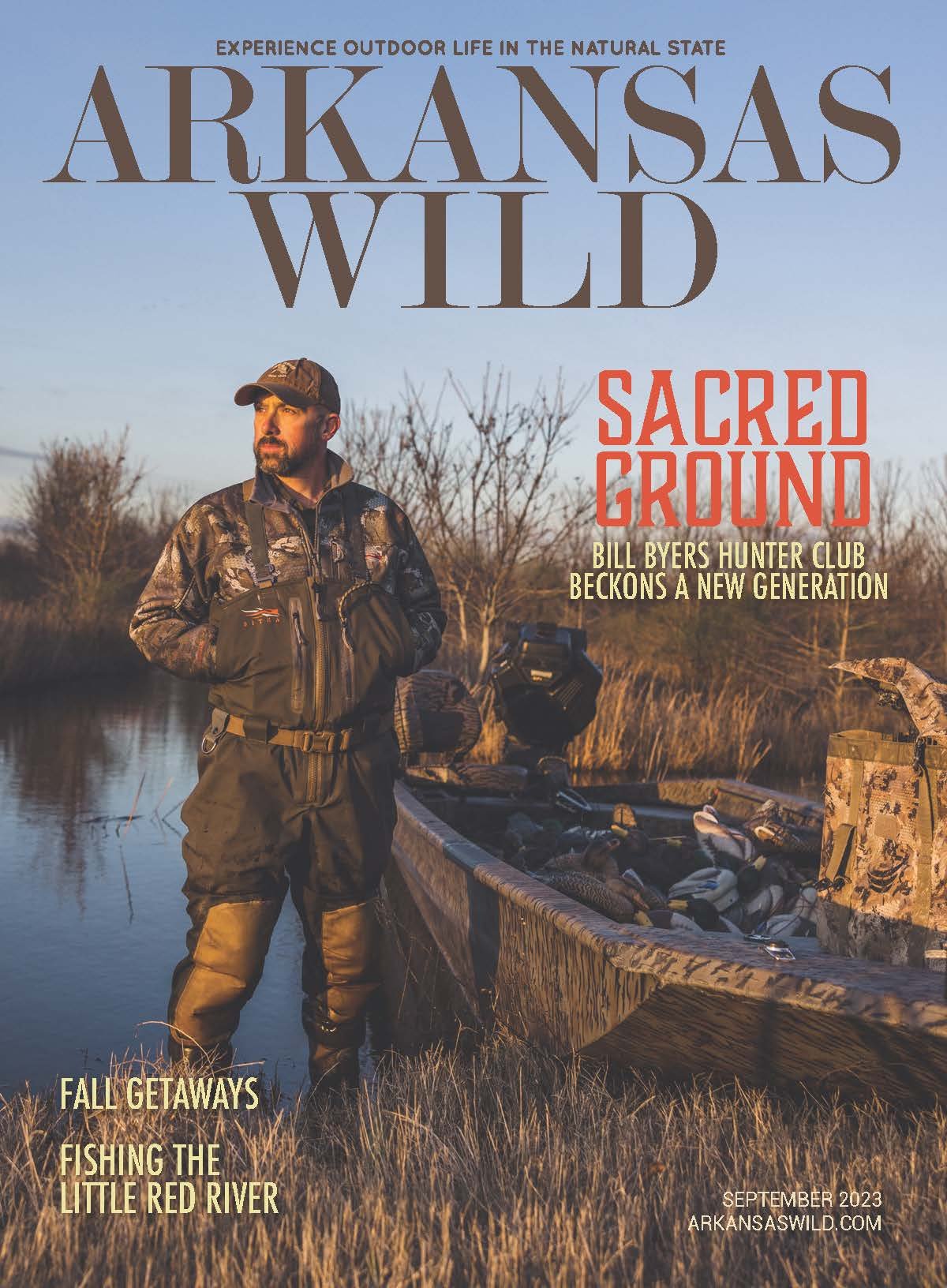It’s All Over But the Flying
Five Oaks sets the bar for waterfowl habitat management
By Richard Ledbetter
A male mallard, commonly seen in Arkansas, comes in for a landing.
Anyone who knows will tell you, there’s no better flooded-timber duck hunting than at George Dunklin’s Five Oaks Lodge on Arkansas Hwy. 152 near Humphrey. That fact isn’t some accident of nature, but rather by design, with decades of scientific waterfowl research and keen observation at its core.
Five Oaks Assistant Wildlife Biologist Reece Butler took us on a February camera hunt to help delay the lingering effects of post-duck season depression. While standing under a grove of red oak, with mallards fluttering down on all sides, he shared his annual routine and the philosophies that drive their consistent success. First on the list is the abundance of natural duck forage floating on the shin-deep waters around us.
Butler said, “After duck season, the first thing on my to-do list is drain the water off the timber and fields. Our chief biologist Jody Pagan says, ‘we want standing water off tree roots by the time spring buds are the size of a mouse’s ear.’”
He explained how, even with the soil still saturated, tree roots are exposed to the air so they take up oxygen. This keeps damage to live-standing, greentimber to a minimum and allows new growth to proceed on schedule.
“A slow draw down is key because then we keep the nutrients and seed stock in place as opposed to the beneficial elements leaving with rapidly receding waters.
Five Oaks Lodge Assistant Wildlife Biologist Reece Butler works yearround preparing the grounds and waters for the annual waterfowl arrival. "We don’t just attract ducks, we hold them."
“We don’t trade ducks here, we hold ducks.” He means that they aren’t at the mercy of ducks moving from food source to food source, or to hoping they’ll respond to decoys and calls to land as they travel from one person’s property to another. Five Oaks works hard to provide enough variety of forage that birds never need to fly beyond their borders for necessary daily fuel. “The biggest contributing factor to holding ducks is carrying capacity. It’s not as much about how many acres of land you have, as quality of habitat. We have a mixture of food plots that include native forage like acorns and grasses in the woods with various ‘hot’ food fields like soybeans, rice and corn surrounding it. Our farming plan is to plant and leave food enough to meet the ‘duck energy day’ requirements of the wildfowl we’re trying to keep here.”
Another of Pagan’s simple yet revolutionary ideas are the “loafing mounds.” The small areas of built-up ground above the waterline in flooded fields give ducks a convenient place to climb up and rest. Pagan says, “If ducks are expending more energy than they’re taking in, they won’t stay around. They’ll go somewhere else.” The mounds provide safe sanctuary surrounded by water for birds to preen and take a break from the effort of swimming.
Butler said, “Mallards can eat their own body weight in a day.” Grinning, he added, “But that’s not to say they can fly afterward.” That’s one more way the loafing mounds prove their worth.
As we enjoyed photographing mallards coming and going from the timber hole, Butler spoke about his chosen occupation. Hailing from near Huntsville, Alabama, he‘s a graduate of Mississippi State University with a degree in wildlife management and a concentration on agriculture. “Besides draining impoundments following the hunt, I spend a lot of time trapping beaver. They’re the biggest enemy to good timber health.
“Come early March, we spend time building water control boxes. We always have to fix, replace or install new control boxes.” Being a certified welder proves mighty handy around a farming operation. They sell not only the numerous control boxes used on the property, but also devices to other hunters and farmers.
“In mid-March I start prepping ground to plant food plots. That involves a lot of grunt work. If I’m not on the tractor plowing or planting, I’m spraying. Next comes irrigation season until the crops are pretty much finished. By mid-August, we’re trying to get all the millet in. Then it’s building catwalks or moving and brushing up duck blinds.
A mallard takes flight from the water.
“Next I bush-hog the woods or I’m on the Bobcat cleaning out duck holes twelve hours a day. With mid-October its time to start pumping up the fields. By the second week of November, we have a few woods holes flooded ready for clients. We bring up the flooding in stages so ducks don’t have access to eat out the forage all at once.”
During the 60-day season Butler becomes a full-time hunting guide, He said, “Its nice to get paid to do something I used to blow all my money on. Of course, I enjoy going out with just my dog and getting my quick six, but guiding has a lot of enjoyable moments as well. There are certain givens when it comes to hunting. One is you’re not going to kill them sitting on the couch.”
“We run big groups through but we have enough guides that nobody has more than three or four clients each. And the faster we get them the better. You’ve got to build a place right but you’ve got to hunt it right too. We’re in and out of the woods and fields by 9:00 a.m. to keep from shooting the ducks out of the area.”
“Happy clients are always my main focus but it’s still hunting,” said Butler, “and there are never any guarantees. If they’re coming they’re coming and if they ain’t they ain’t. You can have all the gadgets and gizmos you want but there’s still nothing like being on the ‘X.’ When they’re coming, let them come. When ducks get ‘mean,’ and won’t work right, I’ll try something different as circumstance arise. I have different philosophies about what to do on certain days. It’s largely weather based. You have to be willing to experiment. Late-season ducks are paired off and start landing in denser areas. Even if they light in the hole, they’ll still swim into the brush to have their privacy.”
“You’re only going to get a limited number of opportunities so you try to kill them outright instead of educating them with a lot of missed shots.”
Besides premiere timber hunting, Five Oaks also hosts excellent field hunts. Butler said, “I enjoy the fields too. But it better be as nasty as can be with a low overcast. In the woods, we prefer a clear blue sky with a whipping wind. You have more room for error under those conditions.
“When I started guiding I was so hard on myself but soon figured out every day can’t be a full-limit day. Now I find more joy in the little things about hunting than the killing.”
Butler concluded saying, “It’s hard work all year long but I wouldn’t want to be anywhere else.”





